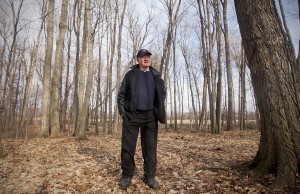
PICTON, Ont. (19/01/12) - Cliff Foster, 80, is the owner of Fosterholm Farms which produces maple syrup among other products. Foster says that he is concerned for the health of his maple trees following reports of Asian longhorned beetle infestation in Toronto. Photo by Melchizedek Maquiso.
By Melissa Di Nardo
Maple syrup producers around Prince Edward County are looking for a way to protect a tree that is a part of Canadian heritage.
The Asian longhorned beetle is threatening the maple tree and an intense eradication program based in the Toronto and Vaughan areas are in place to prevent further infestation.
Maple syrup producer Cliff Foster from Fosterholm Farms in Picton said this aggressively destructive pest is a concern.
“My biggest problem is how are we going to control it. Is there going to be aerial spraying or whatever procedure we have to do?” said Foster.
“We certainly cannot lose all our maples. We lost a lot of the ash trees and the elm. We sure do not want to lose our maple, that’s our heritage. That’s where our maple leaf flag comes from.”
Foster also suggested that farmers and the government need to work more closely together in creating a prevention plan so that there is no reason for massive amounts of tree cutting because of infestation.
The Asian longhorned beetle is an invasive pest that has been destroying forests in North America since 1996. Originally native to Asian countries, this pest was first discovered in New York. The beetle has crossed the border and was found in Toronto on Sept. 18, 2003 and migrated north to Vaughan forests.
Upon the discovery, forests began being tagged and then a week later cut down, being brought to the incinerator to burn in order to prevent further infestation. The destructive level of this beetle is massive and the trees favoured are largely maples. Infestations have also been discovered in horse chestnuts, poplars, willows, elms, mulberries and black locusts. Once the beetle has been discovered, it’s too late and the trees are infested.
The larvae are considered to be the most dangerous since they tunnel up the centre of the tree, ceasing further growth. The adults, on the other hand, are less harmful since they feed off of twigs, leaves as well as bark.
“We don’t know what procedures we need to be doing to combat this disease. This is a serious thing. This pest burrows into the tree. Personally I think aerial spraying is how you would do it. Hopefully there are better ways. We must protect our trees. It’s like any other pest. We have to control things,” said Foster.
Mature beetles usually emerge from hiding in late May all the way through to October, July being their peak month. It has been reported that tree infestation can be detected by looking for exit holes 3/8 to 3/4 inches in diameter (1.5–2 cm), often in the larger branches of the crowns of infested trees. Sometimes sap can be seen oozing from the exit holes with coarse sawdust as evidence on the ground or lower branches.
Currently there are very few predators of the Asian longhorned beetle in North America and there are no known chemicals that can prevent infection or save the hosting trees. Even though the Asian longhorned beetle has not been discovered in Prince Edward County, farmers and maple syrup producers are quite worried that if this beetle does migrate east, they could possibly lose their maple syrup production.
Dr. Taylor Scarr, an insect specialist for the Provincial Forest Entomology team said the last Asian longhorned beetle has not been found in the Toronto and Vaughan area since 2007. “If we manage to keep this area free from the Asian longhorned beetle till the end of 2013, we can declare the area eradicated.”
An area needs to be cleared from an invasive pest for five years in order to be deemed safe. “There is no known insecticide to protect the trees in advance since the beetle dwells within the bark,” said Scarr.
Scarr advised farmers and land owners to “not bring things like palettes or wood crates into forest areas that could be contaminated.”
The main success and early eradication of the Toronto and Vaughan area were due to the strong leadership of all officials to make this a high concern.
Scarr stated that help from the U.S Agriculture Agency provided advice on quick eradication steps.
The beetle was found in Toronto and Vaughan in September and by November, the eradication procedures were in full force.
The next stage is to regenerate the forests and to continue to keep an eye out for this invasive pest, as there is no solution other than clear cutting in order to prevent the spread.
If you have any question or concerns about this in your neighborhood, contact the Ministry of Natural Resources at 1-800-667-1940.